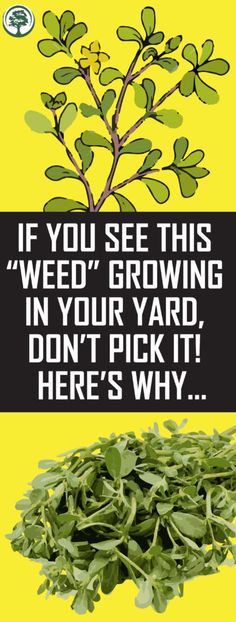Purslane is often referred to as a common weed, and most gardeners are just throw them away, but they actually have a better use.
Eating the leaves have actually been proven to have amazing health benefits, so next time you see a bunch of weeds in your garden, try putting the naturally grown plant to some good use. here’s why you should tare eating purslane…
Antioxidant rich.
Purslane are full of essential antioxidants, and vitamins that are essential to proper health. It is also full of calcium, iron, which help strengthen bones.
With all of these amazing natural health benefits it may even be a cost effective way to replace your nutritional supplements. You should consume it every day to ensure your body gets proper nutrition.
Grows everywhere.
The seeds of the purslane are so strong that a single plant can live over 25 years, so it’s no surprise that it boosts your immune system, and improves your overall health.
Additionally, it is non GMO, loaded with omega-3 fatty acids, and has the most vitamin A of all green leafy vegetables, which helps protect you from several cancers.
Powerful Purslane.
The main focus on this plant has been getting rid of it, but it’s time for that to change. Purslane actually has a pleasant lemon like taste, a crunchy texture, and can be a perfect addition to a recipe, or as a substitute for lettuce and spinach.
It is also great on sandwiches and salads, and its high level of protein will help you build strength.
Even more reasons to try.
Because it is so high in omega-3 fatty acids purslane can have amazing effects on your health. It helps to prevent stroke, and heart disease, and other serious conditions in adults.
Additionally, Children who consume this plant are less likely to develop symptoms of ADHD, Autism, and other developmental disorders.
Purslane nutrition facts
Soft, succulent purslane leaves have more omega-3 fatty acids than in some of the fish oils. If you are a vegetarian and pledge to avoid all forms of animal products, then here is the answer! Go for this healthy dark-green leafy vegetable and soon you will forget fish!
Botanically, this herbaceous leafy vegetable belongs to the family of Portulacaceae and scientifically known as Portulaca oleracea.
Other common names in place for this green leafy are pursley, pigweed, or verdolaga.
Purslane is native to Indian sub-continent and now distributed widely across the continents but actually as a wild weed. There exist varieties of pusley with variation in leaf size, thickness, and leaf arrangement and pigment distribution. This hardy herb plant requires relatively less water and soil nutrients and grows well sunny sunny climates. The plant grows up to 12-15 cm in height as a low-lying spread.
Pursley is widely grown in many Asian and European regions as a staple leafy vegetable. Its leaves appear thick, contain mucilaginous substance, and have a slightly sour and salty taste. Leaves and tender stems are edible. In addition to succulent stems and leaves, its yellow flower buds are also favored, especially in salads.
Purslane seeds, appear like black tea powder granules, are often used to make some herbal drinks.
Health benefits of Purslane
- This wonderful green leafy vegetable is very low in calories (just 16 kcal/100g) and fats; nonetheless, it is rich in dietary fiber, vitamins, and minerals.
- Fresh leaves contain surprisingly more omega-3 fatty acids (a-linolenic acid) than any other leafy vegetable plant. 100 grams of fresh purslane leaves provide about 350 mg of alpha-linolenic acid. Research studies show that consumption of foods rich in omega-3 fatty acids may reduce the risk of coronary heart disease, stroke, and help prevent the development of ADHD, autism, and other developmental differences in children.
- It is an excellent source of Vitamin A, (1320 IU/100 g, provides 44% of RDA) one of the highest among green leafy vegetables. Vitamin A is a known powerful natural antioxidant and an essential vitamin for vision. it is also required to maintain healthy mucusa and skin. Consumption of natural vegetables and fruits rich in vitamin A is known to help to protect from lung and oral cavity cancers.
- Purslane is also a rich source of vitamin C, and some B-complex vitamins like riboflavin, niacin, pyridoxine and carotenoids, as well as dietary minerals, such as iron, magnesium, calcium, potassium, and manganese.
- Furthermore, present in purslane are two types of betalain alkaloid pigments, the reddish beta-cyanins and the yellow beta-xanthins. Both pigment types are potent anti-oxidants and have been found to have anti-mutagenic properties in laboratory studies. [Proc. West. Pharmacol. Soc. 45: 101-103 (2002)].
Preparation and serving methods
The stems and flower buds are also edible. Trim the tough stems near roots using a sharp knife. Cook under low temperature for a shorter period in order to preserve the majority of nutrients. Although antioxidant properties are significantly decreased on frying and boiling, its minerals, carotenes and flavonoids may remain intact with steam cooking.
Here are some serving tips:
- Fresh, raw leaves can be used as salad and as vegetable juice.
- Fresh, tender leaves are used in salads. Saut?ed and gently stewed stems and leaves served as a side dish with fish and poultry.
- It has also been used in soup and curry (Goni soppu curry) preparations and eaten with rice and ragi cake (ragi mudde) in many mouthwatering purslane recipes in South Indian region, especially in parts of erstwhile Mysore province of Karnataka state.
- Stir-fried and mixed with other like-minded greens such as spinach and vegetables, it makes favorite dishes.
